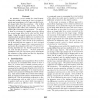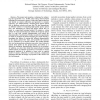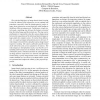115 search results - page 17 / 23 » Visual saliency model for robot cameras |
ATAL
2010
Springer
13 years 8 months ago
2010
Springer
Appearance-based localization compares the current image taken from a robot's camera to a set of pre-recorded images in order to estimate the current location of the robot. S...
ICCV
1998
IEEE
14 years 9 months ago
1998
IEEE
We antroduce a novel method for vasual homang. Usang thas method a robot can be sent to desared posataons and oraentataons an 3-0space specafied by sangle amages taken from these ...
ICRA
2007
IEEE
14 years 1 months ago
2007
IEEE
— Most robotic vision algorithms are proposed by envisaging robots operating in structured environments where the world is assumed to be rigid. These algorithms fail to provide o...
ICRA
2008
IEEE
14 years 1 months ago
2008
IEEE
Abstract— We present and examine a technique for estimating the ego-motion of a mobile robot using memory-based learning and a monocular camera. Unlike other approaches that rely...
ICRA
2002
IEEE
14 years 10 days ago
2002
IEEE
The principal deficiency of image-based visual servoing is that the induced (3D) trajectories are not optimal and sometimes, especially when the displacement to realize is large,...



